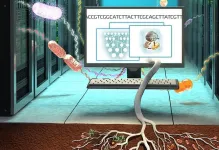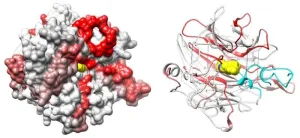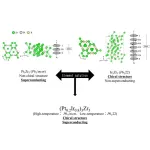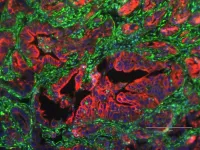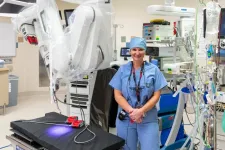(Press-News.org) Climate models are essential to predicting and addressing climate change, but can fail to adequately represent soil microbes, a critical player in ecosystem soil carbon sequestration that affects the global carbon cycle. A team of scientists led by the Department of Energy’s Lawrence Berkeley National Laboratory (Berkeley Lab) has developed a new model that incorporates genetic information from microbes. This new model enables the scientists to better understand how certain soil microbes efficiently store carbon supplied by plant roots, and could inform agricultural strategies to preserve carbon in the soil in support of plant growth and climate change mitigation.
"Our research demonstrates the advantage of assembling the genetic information of microorganisms directly from soil. Previously, we only had information about a small number of microbes studied in the lab,” said Berkeley Lab Postdoctoral Researcher Gianna Marschmann, the paper’s lead author. “Having genome information allows us to create better models capable of predicting how various plant types, crops, or even specific cultivars can collaborate with soil microbes to better capture carbon. Simultaneously, this collaboration can enhance soil health."
This research is described in a new paper that was recently published in the journal Nature Microbiology. The corresponding authors are Eoin Brodie of Berkeley Lab, and Jennifer Pett-Ridge of Lawrence Livermore National Lab, who leads the “Microbes Persist” Soil Microbiome Scientific Focus Area project that is funded by the DOE Office of Science in support of this work.
Seeing the Unseen: Microbial Impact on Soil Health and Carbon
Soil microbes help plants access soil nutrients and resist drought, disease, and pests. Their impacts on the carbon cycle are particularly important to represent in climate models because they affect the amount of carbon stored in soil or released into the atmosphere as carbon dioxide during the process of decomposition. By building their own bodies from that carbon, microbes can stabilize (or store) it in the soil, and influence how much, and for how long carbon remains stored belowground. The relevance of these functions to agriculture and climate are being observed like never before.
However, with just one gram of soil containing up to 10 billion microorganisms and thousands of different species, the vast majority of microbes have never been studied in the lab. Until recently, the data scientists had to inform these models came from only a tiny minority of lab-studied microbes, with many unrelated to those needing representation in climate models.
“This is like building an ecosystem model for a desert based on information from plants that only grow in a tropical forest,” explained Brodie.
The World Beneath our Feet
To address this challenge, the team of scientists used genome information directly to build a model capable of being tailored to any ecosystem in need of study, from California’s grasslands to thawing permafrost in the Arctic. With the model using genomes to provide insights into how soil microbes function, the team applied this approach to study plant-microbiome interactions in a California rangeland. Rangelands are economically and ecologically important in California, making up more than 40% of the land area.
Research focused on the microbes living around plant roots (called the rhizosphere). This is an important environment to study because, despite being only 1-2% of Earth’s soil volume, this root zone is estimated to hold up to 30-40% of Earth’s carbon stored in soils, with much of that carbon being released by roots as they grow.
To build the model, scientists simulated microbes growing in the root environment, using data from the University of California Hopland Research and Extension Center. Nevertheless, the approach is not limited to a particular ecosystem. Since certain genetic information corresponds to specific traits, just as in humans, the relationship between the genomes (what the model is based on) and the microbial traits is transferable to microbes and ecosystems all over the world.
The team developed a new way to predict important traits of microbes affecting how quickly they use carbon and nutrients supplied by plant roots. Using the model, the researchers demonstrated that as plants grow and release carbon, distinct microbial growth strategies emerge because of the interaction between root chemistry and microbial traits. In particular, they found that microbes with a slower growth rate were favored by types of carbon released during later stages of plant development and were surprisingly efficient in using carbon – allowing them to store more of this key element in the soil.
The Root of the Matter
This new observation provides a basis for improving how root-microbe interactions are represented in models, and enhances the ability to predict how microbes impact changes to the global carbon cycle in climate models.
“This newfound knowledge has important implications for agriculture and soil health. With the models we are building, it is increasingly possible to leverage new understanding of how carbon cycles through soil. This in turn opens up possibilities to recommend strategies for preserving valuable carbon in the soil to support biodiversity and plant growth at scales feasible to measure the impact,” Marschmann said.
The research highlights the power of using modeling approaches based on genetic information to predict microbial traits that can help shed light on the soil microbiome and its impact on the environment.
This work was supported by the U.S. Department of Energy (DOE), Office of Biological and Environmental Research.
###
Lawrence Berkeley National Laboratory (Berkeley Lab) is committed to delivering solutions for humankind through research in clean energy, a healthy planet, and discovery science. Founded in 1931 on the belief that the biggest problems are best addressed by teams, Berkeley Lab and its scientists have been recognized with 16 Nobel Prizes. Researchers from around the world rely on the Lab’s world-class scientific facilities for their own pioneering research. Berkeley Lab is a multiprogram national laboratory managed by the University of California for the U.S. Department of Energy’s Office of Science.
DOE’s Office of Science is the single largest supporter of basic research in the physical sciences in the United States and is working to address some of the most pressing challenges of our time. For more information, please visit energy.gov/science.
END
FINDINGS
Scientists at City of Hope®, one of the largest cancer research and treatment organizations in the United States, have discovered a new cellular mechanism that plays an important role in cancer cells’ ability to cause disease. The study was published in Nature Structural & Molecular Biology today.
A team led by Chun-Wei (David) Chen, Ph.D., an associate professor of systems biology at City of Hope, pinpointed two cell-surface proteins, integrin αV and β5, that partner to spur cancer cell growth. The researchers next identified a region of integrin αV called the β-propeller domain ...
For years, there has been a long-held belief that acute viral infections like Zika or COVID-19 are directly responsible for neurological damage, but researchers from McMaster University have now discovered that it’s the immune system’s response that is behind it.
The research, published on Feb. 5, 2024 in Nature Communications, was led by Elizabeth Balint, a PhD student at McMaster, and Ali Ashkar, a professor with the Department of Medicine and the Canada Research Chair in Natural Immunity and NK Cell Function.
“We were interested in trying to ...
Tokyo, Japan – Researchers from Tokyo Metropolitan University have created a new superconductor with a chiral crystalline structure by mixing two materials, one with superconductivity but no chirality, another with chirality but no superconductivity. The new platinum-iridium-zirconium compound transitions to a bulk superconductor below 2.2 K and was observed to have chiral crystalline structure using X-ray diffraction. Their new solid solution approach promises to accelerate the discovery and understanding of ...
(Millbrook, NY) Cary Institute for Ecosystem Studies is launching a new program to support high school and middle school educators in teaching global change and ecology. Starting in the summer of 2024, nine teachers will spend six weeks at Cary Institute conducting collaborative research in ecosystem science. Follow-up meetings throughout the school year will support the teachers as they develop and implement innovative curricula based on their research experiences.
The program is funded by a three-year award from the National Science Foundation as part of its Research ...
U.S. Rep. Katie Porter and former Los Angeles Dodger Steve Garvey are deadlocked in the race for second place in the U.S. Senate primary in California, according to a new poll on California politics and policies from USC; California State University, Long Beach; and Cal Poly Pomona.
U.S. Rep. Adam Schiff, a Democrat, leads all candidates with 25% of likely voters, according to the California Elections and Policy Poll. Porter, a Democrat, and Garvey, a Republican, each received support from 15%. Other candidates are in single digits, with Democratic U.S. Rep. ...
Pancreatic cancer is the No. 3 cause of cancer-related deaths in the United States, and only 12% of patients survive five years after being diagnosed. Severe pancreatic cancer is associated with metastasis, and it is this spread of secondary tumors that usually causes death, but little is known about the molecular mechanisms that drive metastasis.
In a study published Dec. 18 in Advanced Science, researchers from the University of California, Davis showed that abnormal expression of the protein Engrailed-1 (EN1) ...
Food manufacturers often add preservatives to food products to keep them fresh. A primary purpose of these preservatives is to kill microbes that could break down and otherwise spoil the food. Common additives like sugar, salt, vinegar and alcohol have been used as preservatives for centuries, but modern-day food labels now reveal more unfamiliar ingredients such as sodium benzoate, calcium propionate, and potassium sorbate.
Bacteria produce chemicals called bacteriocins to kill microbial competitors. These chemicals can serve as natural preservatives by killing potentially dangerous pathogens ...
Huntsman Cancer Institute at the University of Utah (the U) proudly introduces the first and only single-port robot in the Mountain West for head and neck surgical oncology patients. This state-of-the-art technology is a groundbreaking step in the field of oncological surgery, allowing for greater precision and less invasive procedures. Under the visionary leadership of dedicated healthcare professionals, the institute is committed to revolutionizing treatments for cancer patients.
“I am delighted that Huntsman Cancer Institute can now offer cancer patients in the Mountain West access to this innovative and life-changing technology,” says Sachin ...
Forty-three million Americans lack access to municipal water, and 1 in 10 people globally do not have access to safe drinking water. Rice University’s new WaTER Institute, launched today, aims to address this and other complex water-related challenges.
“Clean water can save more lives than doctors,” said Pedro J. Alvarez , the institute’s director and the George R. Brown Professor of Civil and Environmental Engineering.
The institute’s researchers will also predict and prevent diseases by monitoring wastewater; ...
(February 2, 2024) The National Association of Epilepsy Centers (NAEC) has developed updated guidelines that outline the comprehensive services and resources epilepsy centers should provide to improve quality of care for people whose epilepsy is not well-controlled.
An Executive Summary of the 2023 Guidelines for Specialized Epilepsy Centers: Report of the National Association of Epilepsy Centers Guideline Panel was published online on February 2, 2024, in Neurology®, the medical journal of the American Academy of Neurology. The complete NAEC guidelines are published as an eAppendix on the journal’s website.
Epilepsy is one of the most ...
